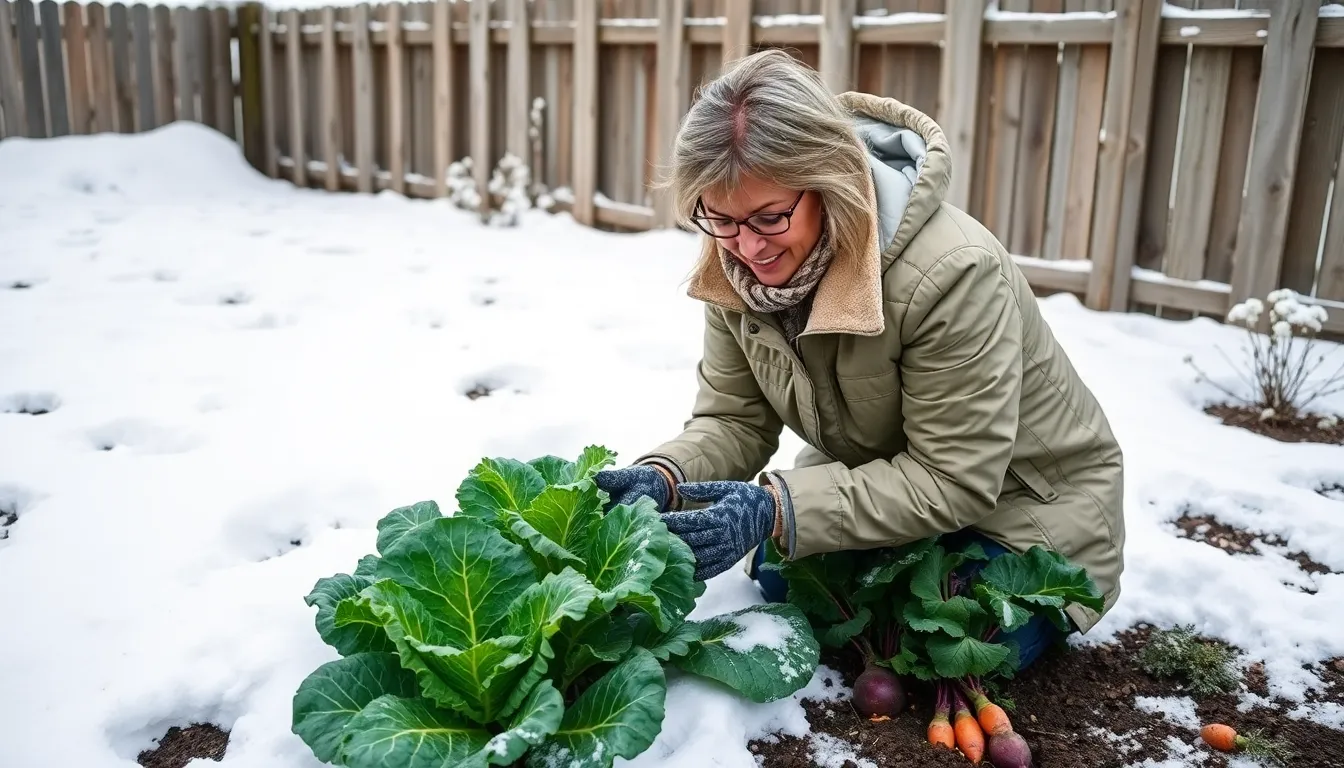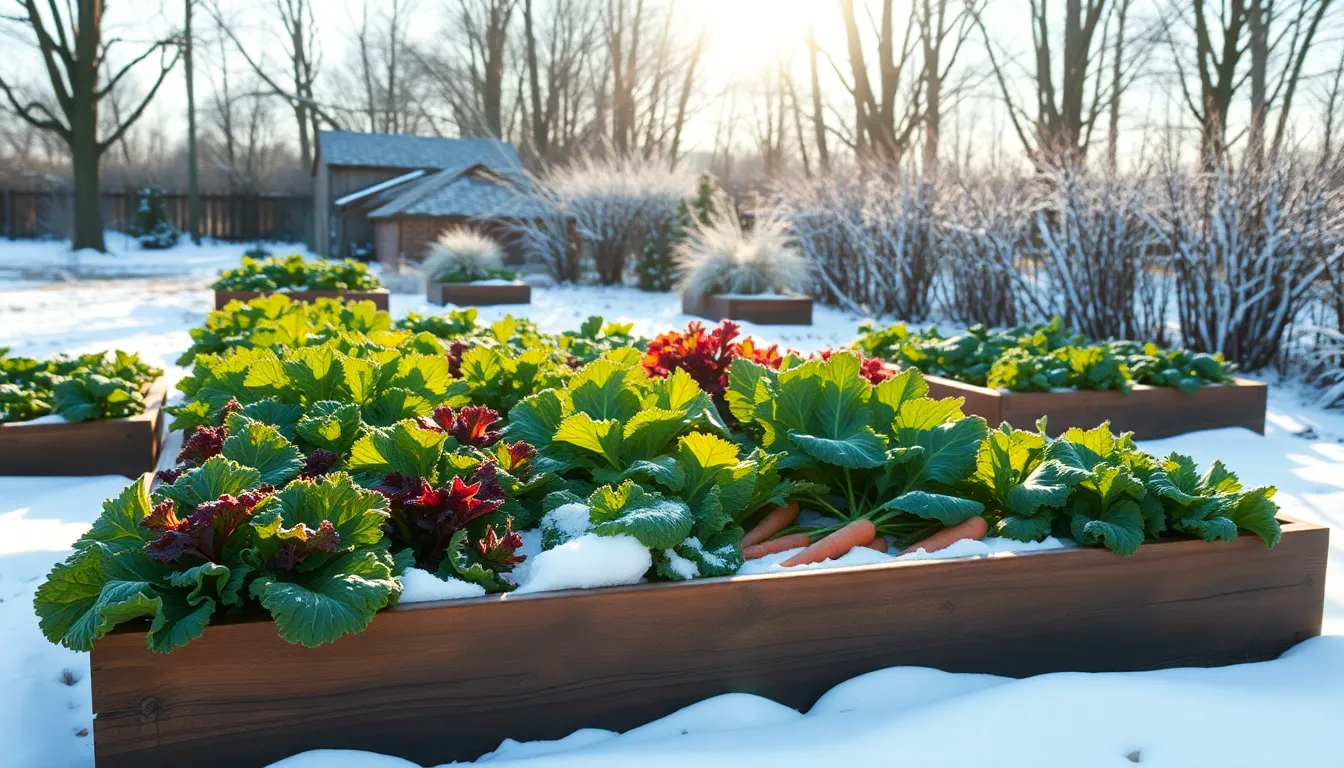Physical Address
304 North Cardinal St.
Dorchester Center, MA 02124
Physical Address
304 North Cardinal St.
Dorchester Center, MA 02124

As the days grow shorter and the temperature drops, many gardeners might think their green thumbs need a winter vacation. But wait! Winter vegetable gardening is not just a possibility; it’s a delicious opportunity waiting to be unearthed. Imagine stepping outside into a frosty wonderland only to find vibrant greens and root vegetables thriving against the chill. It’s like finding a hidden treasure in your backyard.
Winter vegetable gardening offers unique opportunities for gardeners to cultivate a range of crops during the colder months. This approach not only extends the growing season but also enhances the sustainability of gardening practices.
Winter gardening plays a vital role in food security and biodiversity. It allows for the cultivation of crops when fresh produce is scarce, helping to reduce reliance on store-bought options. For local ecosystems, winter gardens contribute to soil health and support beneficial insects by providing habitat. Gardeners frequently discover that by embracing winter gardening, they strengthen their connection to the environment.
Growing vegetables during winter yields numerous advantages. Cold-resistant crops like kale, spinach, and carrots thrive, often tasting sweeter when exposed to frost. These vegetables can enhance nutritional variety and supply essential vitamins during months when other fresh produce is limited. Additionally, winter gardening allows for reduced pest pressure, resulting in fewer chemical inputs. Many gardeners find a sense of accomplishment in harvesting fresh produce regardless of the season, which cultivates resilience in their gardening journey.

Planning a winter garden involves thoughtful strategies to maximize growth and yield during cold months. Gardeners should focus on location and the selection of suitable vegetable varieties.
Location significantly affects winter vegetable gardening success. Positioning the garden in a spot that receives adequate sunlight promotes photosynthesis, even in cooler temperatures. Sheltering the garden from harsh winds, such as using fences or existing structures, creates a more favorable microclimate. Additionally, choosing well-draining soil prevents waterlogging, which can harm root crops. Opting for raised beds also improves drainage and warms the soil quicker, enabling earlier planting and growth.
Selecting the right vegetable varieties ensures a thriving winter garden. Cold-hardy crops like kale, spinach, and carrots excel in lower temperatures and often taste sweeter after frost exposure. Gardener’s choices might include mustard greens, Brussels sprouts, and beets, as these varieties withstand chilly conditions well. For quick harvests, planting radishes and scallions allows for succession planting throughout winter. Evaluating the average frost date and tailoring selections to retain productivity ensures a bountiful harvest all season long.
Preparing for winter gardening requires careful planning and execution. Gardeners increase their chances of successful crops by focusing on soil health and selecting appropriate tools.
Soil health is essential for winter gardening success. Start by testing soil pH, aiming for a neutral range of 6.0 to 7.0. Amendments, such as compost or well-rotted manure, improve fertility and drainage. Tilling the soil incorporates nutrients, while a cover crop, like winter rye, can boost organic matter. Mulching the garden bed with straw helps insulate the soil and retain moisture. Additionally, ensuring the soil is well-aerated prevents compaction.
Using the right tools enhances efficiency in winter gardening. A sturdy shovel assists in turning over soil and planting seeds. Hand trowels are useful for smaller tasks and cultivating seedlings. Garden forks aid in breaking up compacted soil, while row covers protect young plants from frost. Gloves keep hands warm and safe during cold-weather tasks. Finally, a garden hoe supports weed management by breaking up the surface soil and creating a tidy garden space.
Maintaining a winter garden requires strategic efforts in watering, fertilizing, and pest management. Careful attention ensures a thriving garden even in colder temperatures.
Watering plays a crucial role in winter gardening. Soil can dry out during winter, so regular checks are vital. A moisture meter can help gardeners determine when to water. Use water sparingly, ensuring not to overwater, as this can lead to root rot. Fertilizing should focus on organic options. Mixing compost into the soil before planting enhances nutrient availability. Applying a slow-release fertilizer supports plants throughout the growing season. An additional layer of mulch can also help retain soil moisture and regulate temperature.
Pest control remains essential during winter gardening. Beneficial insects like ladybugs can assist in managing natural pests. Inspect plants regularly for any signs of infestations. Applying organic pesticides may be necessary if pests become problematic. Diseases can emerge in damp conditions, so ensuring proper airflow around plants proves beneficial. Disease-resistant varieties offer an added layer of protection. Covering plants with row covers helps prevent diseases and protects against harsh weather. Regular maintenance and monitoring contribute significantly to a healthy winter garden.
Harvesting winter vegetables occurs at specific times for optimal flavor and quality. Gardeners should aim to pick leafy greens like kale and spinach after a frost, as the cold enhances their sweetness. Carrots and beets, on the other hand, can be dug up when they reach desired sizes, typically from late winter to early spring. Timing ensures the vegetables are at their peak, providing essential nutrients during the colder months.
Understanding harvest timings guarantees maximum flavor and nutrition. For leafy greens, harvest occurs when leaves are crisp and vibrant, usually between late fall and early spring. Root vegetables, including carrots and turnips, reach their best taste several months post-planting. Regular monitoring of growth can pinpoint the right moment to pull them from the soil. Frequent inspection helps determine ripeness, allowing for selective harvesting based on individual vegetable types.
Using proper preservation techniques ensures freshness lasts beyond the growing season. Freezing is an effective method; it maintains nutrients and flavor while providing easy access to vegetables. Blanching vegetables before freezing stops enzyme actions that may cause loss of flavor. Canning also preserves winter yields; it allows for longer storage without losing essential nutrients. Various drying methods can work as well, concentrating flavors while offering lightweight storage options. Choosing the right method depends on personal preferences and available resources, providing flexibility in preserving harvests.
Winter vegetable gardening opens up a world of possibilities for dedicated gardeners. By embracing the colder months, they can cultivate a variety of nutritious crops while contributing to food security and biodiversity. The unique challenges of winter gardening foster resilience and creativity, transforming the garden into a productive oasis even in harsh conditions.
With careful planning and attention to detail, gardeners can enjoy the sweet rewards of winter-hardy vegetables. The satisfaction of harvesting fresh produce during this time not only enhances meals but also nurtures a deeper connection to the gardening journey. Winter gardening is more than just a seasonal activity; it’s a commitment to sustainable practices and a healthier lifestyle.